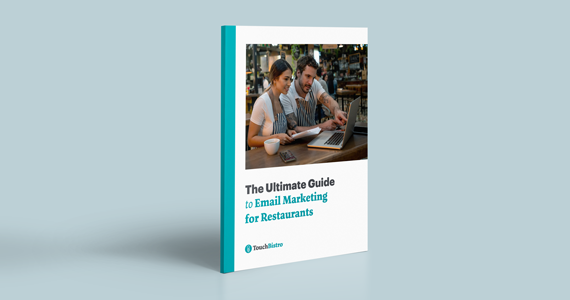A restaurant newsletter is a powerful way to engage your restaurant customers. It gives business owners the chance to offer guests relevant content that boosts brand awareness and drives repeat visits.
Best of all, a newsletter can be part of your overall restaurant email marketing strategy. While newsletters can help to drive sales, the main focus is sharing information with your guests. You can let guests know what’s new and exciting to encourage actions, like ordering from your latest food menu, or checking out your most recent blog post, for example.
Just how effective are newsletters? Lenfest Institute’s report found that the likelihood of a casual reader becoming a paid subscriber increases if someone reads five articles a month or becomes a newsletter subscriber. Additionally, email generates $42 for every $1 spent. With such an impressive return on investment (ROI), it’s clear that a restaurant newsletter is a cost-effective option for marketing your venue.
If you want to get started, or update your existing newsletter, this article covers how to write a newsletter for a restaurant in just four easy steps:
- Creating a plan for your newsletter
- Choosing your restaurant newsletter template
- Filling in the contents of your restaurant newsletter
- Sending your newsletter

How to Create a Restaurant Newsletter in 4 Steps
Create a Plan for Your Newsletter
Planning can increase your chance of success. Whether you’re starting from scratch or updating a pre-existing newsletter, consider these steps before creating your newsletter content – establish your brand, set your goals, and grow your email list.
Establish Your Brand
Include your restaurant’s logo and colors in your newsletter updates. This will let your readers know the email is from you before they read it. Here are a few other design tips to consider:
- Tone: Make sure your newsletter communicates your restaurant’s tone. For example, if your restaurant promotes healthy eating, consider a simple layout and images of fresh dishes.
- Font: Choose a font that matches your branding in the newsletter. Most importantly, ensure there is a contrast with the background so it’s easy to read. Black or dark grey fonts will do the trick.
- Colors: Use colors that are in your logo in your newsletter, but use them moderately. They can add a nice pop of color on a white background and make your text easy to read.
Set Your Goals
Setting your goals and objectives upfront can help increase the value of your newsletter. Here are a few goals to consider before starting the newsletter writing process:
- The purpose of your newsletter: Consider what actions you would like your readers to take, and what content will help them do that. Will you include restaurant reviews or staff profiles? How about menu updates, promotions, and events?
- Your customer base: Do you understand your customers and what motivates them? Consider their interests. For example, do they enjoy dining at home? Are they looking for your latest menu updates? Refer to them when creating content.
- Your frequency for sending: This depends on how much content you would like to include. You can start sending newsletters once a month to begin with. Then, if you have enough content, you can increase your frequency to weekly or bi-weekly.

Learn how to set up an email marketing strategy for your business in 6 easy steps.
Grow Your Email List
Before scheduling your newsletter, you first need to build your email list. Thankfully, there are many restaurant marketing ideas you can use to encourage diners to sign up for your list:
- Use a Sign: Your existing customers are already interested in upcoming specials, discounts, and announcements. Promote your newsletter on a sign, whether physical or digital, inside your restaurant, or give guests a sign-up form to fill in when they check out. Let them know that by signing up, they will be the first to know about your latest promotions, like your Canada Day restaurant specials, for example.
- Website Form: Visitors are already browsing your website to find your menu, operating hours, or to book reservations. Use a website form to capture these potential diners by giving them an easy way to sign up for updates from your restaurant.
- Social Media: Showcase your exclusive newsletter content on social media so followers will want to join the list – especially if your newsletter includes coupons and discounts. Your followers are already interested in your content, so this is a great way to keep them engaged.
- Special Offers: Provide an extra incentive for your guests to join your email list. For example, you can offer an exclusive discount for online orders, a free hot drink or dessert, or a free appetizer with their next order.

Choose Your Restaurant Newsletter Template
You can create an eye-catching design with a newsletter template. A newsletter template is a file that’s designed professionally, with programs like Adobe Photoshop, Illustrator or InDesign. It’s an overall layout of placeholder text, images, and graphics that can easily be replaced with information related to your venue.
Restaurant newsletter templates are tremendously helpful because they can be used every time you put together your newsletter to establish brand consistency. Also, they can save you time and money because you won’t need to create a new design every time you send an update.
Many email marketing software services, such as Mailchimp, Sendinblue, or Benchmark, include restaurant newsletter templates – or you can create your own.
A newsletter template may also come with your restaurant loyalty program. This is ideal because it means you can easily send targeted marketing promotions to your most loyal customers.
No matter what email software you use, start with a newsletter template that complements your restaurant’s brand. Then, customize your template by using content blocks to organize your text and images. These content blocks can be filled out with your restaurant specials, events, promo codes, and more. By using the same content blocks each time you create a newsletter, you’ll ensure your content is uniform and easy to digest.
5 Tips for Designing Your Ultimate Template
As you’re building your newsletter template, keep the following tips in mind:
1. Consistent Brand Experience
Your email newsletter has a variety of elements, like colors, text, imagery, logos, and clickable buttons. Each of these elements reflects your restaurant’s branding strategy. A consistent design will help subscribers recognize your brand. It will also help readers navigate your content better, according to UX Collective.
2. Reflect Your Brand Voice
Your brand voice is your restaurant’s personality. It helps your brand attract new customers, create meaningful connections, and build trust. To create a strong brand voice, stay true to your restaurant mission statement and vision, and always use a conversational tone with your customers.
3. Make It Mobile-Friendly
To reach more readers, it’s important to check that your design is mobile-friendly. This means that anyone can access and read your newsletter on any device they prefer to use – whether that’s a computer, smartphone, tablet, e-reader, or even a smartwatch.
4. Consider Your Ideal Length
The optimal length for a newsletter is about 20 lines of text, or 200 words maximum, to achieve the highest click rate. A click rate is the percentage of people who will click on a link or image within your email newsletter.
However, length isn’t a hard rule. Consider your subscribers’ preferences, and your newsletter performance, such as click rate. The higher your click rate, the more engaged your readers are – which can help you determine the best length for your specific audience.
5. Keep It Effective and Simple
Customers may be in a rush to find your menu or order food. It’s important that your newsletter can be read, scanned, and clicked quickly. Don’t use too many images, text, or fonts that are distracting. Instead, keep your layout simple with clear titles and bullet points.

Learn how to set up an email marketing strategy for your business in 6 easy steps.
Fill In the Contents of Your Restaurant Newsletter
Once your template is built, it’s time to start thinking about how to write a newsletter for a restaurant. When creating content, there are many elements you’ll need to complete, including:
Subject Line and Preheader
Your subject line is the first thing your subscribers see when they check their emails. Therefore it needs to be attention-grabbing. In no more than seven words, you need to pique the reader’s interest and describe what your email is about.
While you think of a catchy title, remember to keep your brand personality and content in mind.
A preheader is the text that follows the subject line when your email is previewed. In about 5-8 words, it provides a little more information to intrigue readers and encourages them to open your newsletter. Typically, it showcases one of your content blocks.
For example, if your newsletter announces your new winter menu, the preheader may be an introduction to your latest seasonal dessert.
Images and Visuals
After your subject line and preheader convince a subscriber to open your newsletter, your images are what makes the next impression. Therefore you need to ensure your images and visuals are relatable to your reader.
For example, consider visuals that are inclusive and represent your community. Images should shine a light on your restaurant – such as specialty dishes, artisan plateware, or a chef thoughtfully preparing a meal.
Headline and Subheader
A headline is the title of your article, whereas your subheader is a secondary title underneath. Keep your headline and subheader simple and short, while telling subscribers what to expect next. Like a news headline, make sure it urges your customers to keep reading.
Keep it to the point, like, “Introducing our Easter Menu” or “Get 15% off dinner today!”
Message Body
The body of your newsletter holds the majority of your information. While it gives you an opportunity to write creatively, you should avoid overwhelming your audience with too much content. Instead, use each content block to write concisely and keep your readers engaged.
Aside from updates, here’s a handful of restaurant newsletter ideas you can use:
- Blog Updates: Write a summary of your top blog posts, and add a button that allows readers to access the articles from your newsletter.
- Social Media Posts: Show how your customers are interacting with your restaurant on social media, including contests you’re running or fun social campaigns.
- Customer Reviews: Showcase customer reviews that shine a positive light on your restaurant or food.
- Tutorials, Recipes, or Guides: Share recipes, guides, or video tutorials. For example, how to make one of your signature cocktails or a guide to holiday meal planning.
- Special Offers and Events: You can highlight upcoming promotions, your restaurant reward program, or exciting events in your newsletter.
- Customer & Staff Stories: Share any stories from customers or staff about what they like about your restaurant.

Learn how to set up an email marketing strategy for your business in 6 easy steps.
Call to Action
Your call to action (CTA) button tells readers what you want them to do after reading your newsletter. “Read the blog”, “order online” or “see more” are typical examples. You can use a CTA to increase traffic to your restaurant website, get customers to fill out forms, and drive sales.
Footer and Contact Information
A footer is a section that appears in the bottom margin of your newsletter. It typically includes your contact information so subscribers can reach you. Additionally, you can add your website link, your physical location, your email, phone number, and clickable social media buttons.
Send Your Newsletter
When you’re ready, you can send your newsletter using an email marketing service. You’ll need to have a contact list with at least one group identified. Send your newsletter manually or automate the process of sending a newsletter so you can set it and forget it.
6 Great Restaurant Newsletter Examples
Every successful email newsletter focuses on speaking to its audience and meeting their needs. Whether that’s an engaging voice or an intriguing call-to-action, adding some personality will make your restaurant newsletter entertaining to read. In addition to looking into the top restaurant email examples, here are six great examples that include restaurant newsletter ideas you can use right away:
1. Planta Cocina: Special Offer
Planta Cocina highlights their 2-for-1 tacos special for International Taco Day with food photography and vibrant colors.
2. Momofuku: Restaurant Community
Momofuku puts a friendly face to their restaurant by showing a photo of famous chef David Chang, followed by a 10% off promotional incentive for first-time diners.
3. Risotteria Melotti: Recipe
Risotteria Melotti wishes guests a happy Thanksgiving Day and shares an enticing holiday recipe. The restaurant also encourages guests to reserve a table – a great example of a clear call to action!
4. Urbe Houston: Sharing a menu
Urbe Houston promotes their breakfast menu with professional photos of savory street foods of Mexico. Call-to-action (CTA) buttons urge readers to view the menu or order online.
5. Otto’s Berlin Döner: Celebrating a Special Occasion
Otto’s Berlin Döner celebrates the restaurant’s fifth anniversary in business by thanking patrons with $5 cans of ale and lager.
6. Hearth East Village: Loyalty Program
Hearth East Village tells friends and family about its membership program, Cellar Share, where guests can choose 3 to 5 bottles each month.
A newsletter is a powerful way to improve guest engagement by attracting new customers and having guests continue to come back to your restaurant. With compelling copy and the right design considerations, you can create a valuable restaurant newsletter that grabs your audience’s attention, boosts loyalty, and increases sales.
Free social media templates for your restaurant
Sign up for our free weekly TouchBistro Newsletter







